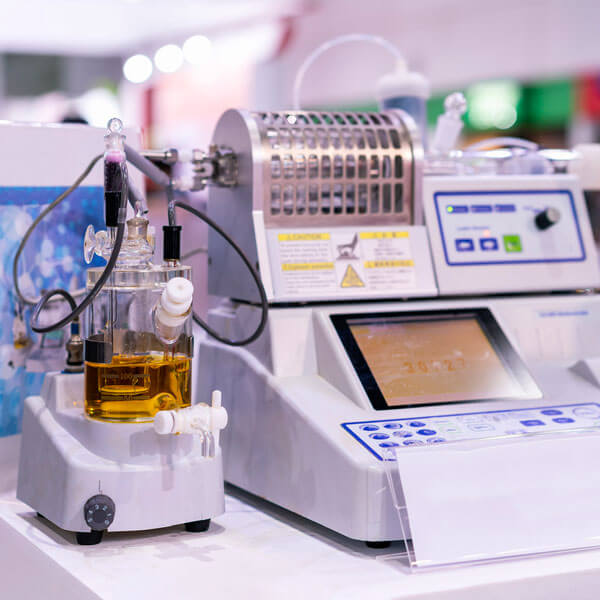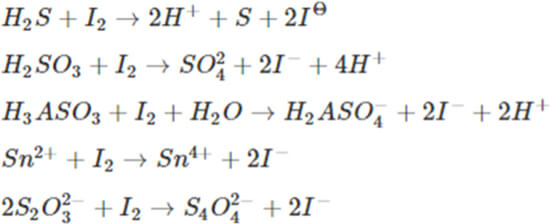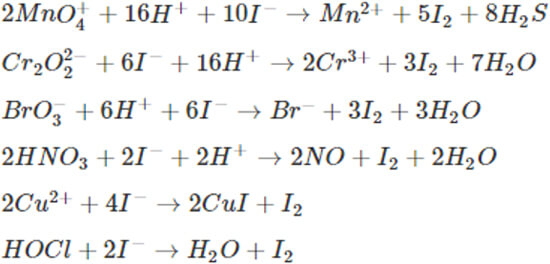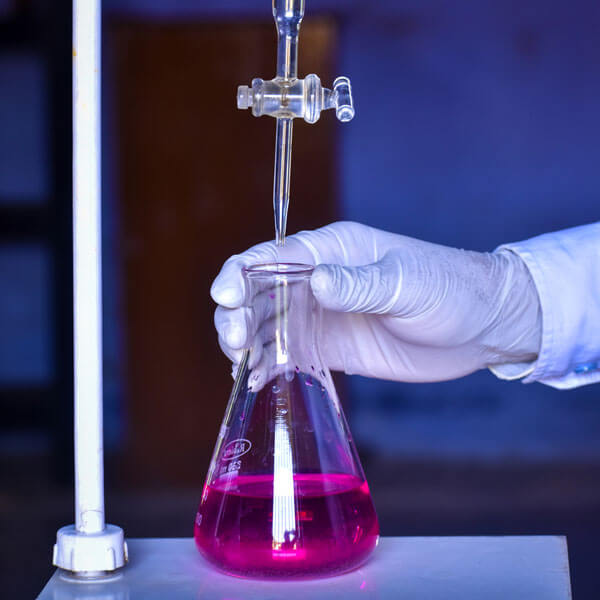Titrations
A Widely Used Laboratory Technique Benefiting the DFW Metroplex
Titration is a widely used laboratory technique that analyzes and ascertains the known concentration of another solution using a solution with a known concentration. Until the reaction is finished, the known quantity of the analyte (the unknown solution) is usually mixed with the titrant (the known solution) using a burette. An indicator is frequently used to indicate the endpoint, or the point at which the reaction ends. TTI Labs understands what it takes to gather essential data, maintain a clean chain of command, and analyze compounds in our laboratory.

Different Titration Types
Titration comes in a variety of forms, each with its own objectives and methods. The four common titrations are:
- Acid-Base Titrations
- Redox Titrations
- Precipitation Titrations
- Complexometric Titrations
Redox titration and acid-base titration, however, are the two most often used titration methods in quantitative chemical analysis.
Acid-Base Titrations
Details +
By neutralizing the other acid or base at the known concentration, an acid-base titration is a chemical testing procedure used to find the unknown concentration of an acid or base. Chemical purity can also be determined via acid-base titration.
HA + BOH → BA + H2O
Acid + Alkali → Salt + Water
Or (H+) + (OH–) → H2O
The basis of an acid-base titration is the reaction that takes place when an analyte and a base or acid neutralize each other. This type of titration involves combining a reagent with the sample solution until the pH level is reached. The pH or pH meter's track change is the primary determinant of this kind of titration.
Redox Titrations
Details +
Redox titration is a laboratory technique that uses a redox reaction between the titration and the analyte to determine the concentration of a certain analysis. A potentiometer or redox indicator may occasionally be required for this kind of titration. Another name for it is an oxidation-reduction process.
Electrons are transferred between the titrant and the utilized analyte during redox titration. These titrations have the following names, which correspond to the reagents used in them:
-
Permanganate Titrations
In this case, diluted sulfuric acid is employed to retain the oxidizing agent, potassium permanganate. Before reaching the finish, the solution is still colorless. The formula is:
2KMnO4 + 3H2SO4 → K2SO4 + 2MnSO4 + 3H2 + 5O
Or MnO4– + 8H + 5e → Mn2++ 4H2O -
Dichromate Titrations
As an oxidizing agent in this titration, potassium dichromate is utilized. Sulfuric acid that has been diluted is used to keep the medium acidic. Potassium dichromate solution can be used straight to titrate. The formula is:
K2Cr2O7 + 4H2SO4 → K2Cr2(SO4) + 4H2O + 3[O]
Or Cr2O27- + 14H + 6e → 2 Cr3+ + 7H2O -
Iodimetric and Iodometric Titrations
Iodimetric and iodometric titrations involve the reduction of free iodine to iodide ions and the oxidation of iodide ions to free.
l2 + 2e → 2l–……………. (reduction process)
2l– + 2e → 2e ……………. (oxidation process)

-
Reactions Involved in Iodimetry Titration:

-
Reactions Involved in Iodometry Titration:
As an indicator, the solution is employed. While an oxidation agent is used in the iodometric titration to react and release free iodine, free iodine is used in the iodometric titration.
-
Precipitation Titrations
Details +
Precipitation titration, which occurs when two reacting chemicals come into contact, is based on insoluble precipitation. When the titrant and analyte interact, an insoluble substance is created. The titration keeps going until all of the analysis is used up. The indicator interacts with the excess titrant, signaling the end of the titration procedure.For instance, we can titrate a solution with a known quantity of silver nitrate to find the chloride ion concentration in that solution. The following is how the reaction happens:
Ag+(aq) + Cl–(aq)→ AgCl(s)
During titration, AgCl is visible to sink to the bottom of the reservoir as a white precipitate. Practically speaking, the amount of chloride ion present is equivalent to the amount of silver ion used for the equivalency point.
Complexometric Titrations
Details +
At an equivalency point, an undivided complex forms during the complexometric titration. There won't be any inaccuracy because of co-precipitation because this is greater than the precipitation titrations.
Hg2+ + 2SCN– → Hg(SCN)2
Ag+ + 2CN– → [Ag(CN)2]–
The significant solution ethylenediaminetetraacetic acid (EDTA) combines with metals.

Titration Curve
Plotting the pH of the analyte solution against the volume of titrant added as the titration proceeds results in a titration curve. The volume of titrant added since the start of the titration is represented by the x-coordinate of a titration curve. The analyte concentration at the appropriate titration stage is represented by the y-coordinate. The strength of the associated acid and base is primarily represented by the titration curve in an acid-base titration.
Determining a Titration’s Final Point
An end-point is a physical shift in the solution that signifies the titration’s conclusion. It serves as a cue to testers to cease titrating the analyte further. Any type of visual sign, such as a color shift, a precipitate that is visible, or a change on an electronic readout, is typically used to indicate it.
Performing a Routine Titration to Determine the Concentration of a Analyte
Groundwater testing is crucial for ensuring the purity and safety of drinking water, as it is a primary source for millions of people worldwide. It plays a pivotal role in safeguarding public health, protecting ecosystems, and preventing contamination. The tests involved in Ground testing help prevent contamination, ensure the sustainability of groundwater, and safeguard the health and well-being of communities and ecosystems that depend on it. Regular monitoring and thorough analysis of groundwater quality are essential for maintaining public health and preserving the delicate balance of these ecosystems.
Fill the burette with the known-concentration solution (the titrant) and place a known volume of the unknown-concentration solution (the analyte) in a flask.
Let the titrant drop into the analyte by slowly opening the burette tap. Choose the appropriate titration speed: if it is too rapid, the equivalency point will be exceeded, and if it is too slow, the titration length will be unduly extended.
Monitor the analyte’s color; a change in color typically signifies the end of the titration. Lastly, utilize the following formula to find the analyte’s concentration assuming the titrant and analyte are in a 1:1 mole ratio.
M titrant x V titrant = M analyte x V analyte where,
M titrant = Molarity (M) of the titrant,
V titrant = Volume (V) of the titrant,
M analyte = Molarity (M) of the analyte, and,
V analyte = Volume (V) of the analyte.
Recall that the concentration of a solution is known as its molarity, and it is measured in moles of solute per liter of solution.
Load More
Application of the Titration
Actually, volumetric analysis is the term used to describe titration. Numerous businesses rely on this technology for the synthesis and examination of significant chemical substances. These prominent applications of titration in a range of industries that impact numerous facets of society are as follows:
When developing new medications, a specific quantity of ingredients is required. Titration is the process that completes this measurement of the chemical quantity. The pharmaceutical sector uses a variety of titration techniques, including pH-stat titration, precipitation titrations, purity analysis, and content analysis.
Titration is used by winemakers in the winemaking process. This enables them to enhance the wine's flavor and inspect the quality of the raw materials used in production. Titration is used for final quality control and aids in batch testing during fermentation.
The titration procedure is used in the automotive sector to create biodiesel oil. In order to maintain the functionality of biodiesel oil, a specific pH level is needed. Titration serves this goal well. After measuring the pH of the biodiesel, manufacturers calculate how much base is needed to get the pH level up to the required level.
Two main uses of titration techniques in this industry are quality control and meeting regulatory criteria. Testing and measuring the amount of various minerals used in the manufacture of food and beverages should be done by every producer. By using complexometric titration and precipitation, the existence of these minerals is ascertained. Acid-base titration is a quality control method used by manufacturers. Controlling the manufactured food's flavor, texture, nutrition, consistency, and appearance is crucial.
Manufacturers must add the right amount and concentration of chemicals to ensure the manufacturing of high-quality cosmetics. Titration is a method that producers employ to find the best base for cosmetics. For instance, coconut oil is a common base used in cosmetic products.

What Is a Burette?
Burettes are laboratory instruments that are frequently used in chemical and industrial testing, particularly for the volumetric analysis titration procedure, to dispense and quantify varied volumes of liquid or occasionally gas. Burettes’ volume, resolution, and dispensing precision can all be specified. Reduced volume and higher resolution are produced by tubes with a smaller diameter. Digital burettes are less reliant on the technician’s competence and can achieve greater precision.
Chemists in the 19th century invented the first burette. It was only a straightforward glass tube with valves and graduations added later. Glass burettes still make extensive use of this fundamental design. Make sure there are no bubbles in the liquid and that the reading is obtained at the meniscus’s bottom by closely observing this at eye level. The difference between the initial and final reagent measurements is the supplied volume.
When Is Burette Calibration Required?
The burette needs to be well-maintained and calibrated to ensure the quality of the titration results is maintained. Generally speaking, a number of criteria determine how often a burette needs to be calibrated:
- Frequency of burette use
- Type of liquid dispensed by the burette
- Long period of non-usage
- Handling and care of burette
- Titration applications that require superior accuracy also demand more frequent calibration
The FDA and ASTM International, for example, issue guidelines and regulations that set minimum requirements to guarantee the quality of laboratory test results. Regulations mandate that routine calibrations at appropriate intervals be performed on all laboratory instruments, including pipettes and burettes, used in sampling and production processes.
The Clinical and Laboratory Standards Institute (CSLI) has published guidelines for pipettes and burettes in the same series, stating that these instruments need to be calibrated every three to six months. Additionally, testing with 10 replicas at both nominal and lowest settings needs to be done on a least of two volumes. Setting up a suitable calibration frequency guarantees traceability, accountability, and findings that can be trusted while reducing the possibility of improper liquid supply in the lab.
